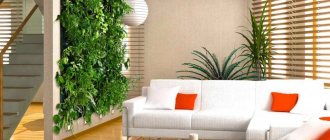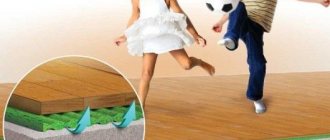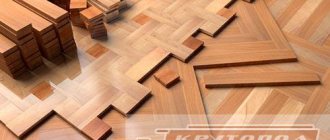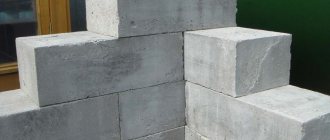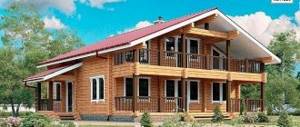What is KTP building material?
Theoretically, and practically too, building materials, as a rule, create two surfaces - external and internal. From a physics point of view, a warm region always tends towards a cold region.
In relation to building materials, heat will tend from one surface (warmer) to another surface (less warm). In fact, the ability of a material to undergo such a transition is called the thermal conductivity coefficient, or in the abbreviation KTP.
Diagram explaining the effect of thermal conductivity: 1 – thermal energy; 2 – thermal conductivity coefficient; 3 – temperature of the first surface; 4 – temperature of the second surface; 5 – thickness of building material
The characteristics of the CTS are usually based on tests, when an experimental specimen measuring 100x100 cm is taken and a thermal effect is applied to it, taking into account the temperature difference of two surfaces of 1 degree. Exposure time 1 hour.
Accordingly, thermal conductivity is measured in Watts per meter per degree (W/m°C). The coefficient is denoted by the Greek symbol λ.
By default, the thermal conductivity of various materials for construction with a value of less than 0.175 W/m°C equates these materials to the category of insulating.
Modern production has mastered technologies for the production of building materials whose CTP level is less than 0.05 W/m°C. Thanks to such products, it is possible to achieve a pronounced economic effect in terms of energy consumption.
Influence of factors on the level of thermal conductivity
Each individual building material has a specific structure and has a unique physical state.
The basis of this are:
- dimension of crystal structure;
- phase state of matter;
- degree of crystallization;
- anisotropy of thermal conductivity of crystals;
- volume of porosity and structure;
- direction of heat flow.
All these are influencing factors. The chemical composition and impurities also have a certain influence on the level of CTP. The amount of impurities, as practice has shown, has a particularly pronounced effect on the level of thermal conductivity of crystalline components.
Insulating building materials are a class of products for construction, created taking into account the properties of PTS, close to optimal properties. However, achieving ideal thermal conductivity while maintaining other qualities is extremely difficult.
In turn, the PTS is influenced by the operating conditions of the building material - temperature, pressure, humidity level, etc.
Building materials with minimal package transformer
According to research, dry air has a minimum thermal conductivity value (about 0.023 W/m°C).
From the point of view of using dry air in the structure of a building material, a structure is needed where dry air resides inside numerous closed spaces of small volume. Structurally, this configuration is represented in the form of numerous pores inside the structure.
Hence the logical conclusion: a building material whose internal structure is a porous formation should have a low level of CFC.
Moreover, depending on the maximum permissible porosity of the material, the thermal conductivity value approaches the value of the thermal conductivity of dry air.
The creation of a building material with minimal thermal conductivity is facilitated by a porous structure. The more pores of different volumes are contained in the structure of the material, the better CTP can be obtained
In modern production, several technologies are used to obtain the porosity of a building material.
In particular, the following technologies are used:
- foaming;
- gas formation;
- water sealing;
- swelling;
- introduction of additives;
- creating fiber scaffolds.
It should be noted: the thermal conductivity coefficient is directly related to properties such as density, heat capacity, and temperature conductivity.
The thermal conductivity value can be calculated using the formula:
λ = Q / S *(T1-T2)*t,
Where:
- Q – amount of heat;
- S – material thickness;
- T1, T2 – temperature on both sides of the material;
- t – time.
The average value of density and thermal conductivity is inversely proportional to the value of porosity. Therefore, based on the density of the structure of the building material, the dependence of thermal conductivity on it can be calculated as follows:
λ = 1.16 √ 0.0196+0.22d2 – 0.16,
Where: d – density value. This is the formula of V.P. Nekrasov, demonstrating the influence of the density of a particular material on the value of its CFC.
The influence of moisture on the thermal conductivity of building materials
Again, judging by examples of the use of building materials in practice, the negative effect of moisture on the quality of life of a building material is revealed. It has been noticed that the more moisture the building material is exposed to, the higher the CTP value becomes.
In various ways they strive to protect the material used in construction from moisture. This measure is fully justified, given the increase in the coefficient for wet building materials
It is not difficult to justify this point. The effect of moisture on the structure of a building material is accompanied by humidification of the air in the pores and partial replacement of the air environment.
Considering that the thermal conductivity parameter for water is 0.58 W/m°C, a significant increase in the thermal conductivity of the material becomes clear.
It should also be noted that there is a more negative effect when water entering the porous structure is additionally frozen and turns into ice.
Accordingly, it is easy to ask
Table of thermal conductivity of building materials: coefficients
This table contains thermal conductivity indicators for the most common building materials. Using such reference books, you can easily calculate the required thickness of the walls and the insulation used.
Table of thermal conductivity coefficient of building materials:
Table of thermal conductivity of building materials: coefficients
Conclusions and useful video on the topic
The video is thematically oriented, explaining in sufficient detail what KTP is and “what it is eaten with.” After familiarizing yourself with the material presented in the video, you have a high chance of becoming a professional builder.
The obvious point is that a potential builder must know about thermal conductivity and its dependence on various factors. This knowledge will help you build not only with high quality, but with a high degree of reliability and durability of the object. Using a coefficient essentially means saving money, for example, on paying for the same utilities.
If you have questions or valuable information on the topic of the article, please leave your comments in the block below.
Thermal conductivity coefficient of materials.
The table below shows the values of the thermal conductivity coefficient for some materials used in construction.
| Material | Coeff. warm W/(m2*K) |
| Alabaster slabs | 0,470 |
| Aluminum | 230,0 |
| Asbestos (slate) | 0,350 |
| Fibrous asbestos | 0,150 |
| Asbestos cement | 1,760 |
| Asbestos cement slabs | 0,350 |
| Asphalt | 0,720 |
| Asphalt in floors | 0,800 |
| Bakelite | 0,230 |
| Concrete on crushed stone | 1,300 |
| Concrete on sand | 0,700 |
| Porous concrete | 1,400 |
| Solid concrete | 1,750 |
| Thermal insulating concrete | 0,180 |
| Bitumen | 0,470 |
| Paper | 0,140 |
| Light mineral wool | 0,045 |
| Heavy mineral wool | 0,055 |
| Cotton wool | 0,055 |
| Vermiculite sheets | 0,100 |
| Woolen felt | 0,045 |
| Construction gypsum | 0,350 |
| Alumina | 2,330 |
| Gravel (filler) | 0,930 |
| Granite, basalt | 3,500 |
| Soil 10% water | 1,750 |
| Soil 20% water | 2,100 |
| Sandy soil | 1,160 |
| The soil is dry | 0,400 |
| Compacted soil | 1,050 |
| Tar | 0,300 |
| Wood - boards | 0,150 |
| Wood – plywood | 0,150 |
| Hardwood | 0,200 |
| Chipboard | 0,200 |
| Duralumin | 160,0 |
| Reinforced concrete | 1,700 |
| Wood ash | 0,150 |
| Limestone | 1,700 |
| Lime-sand mortar | 0,870 |
| Iporka (foamed resin) | 0,038 |
| Stone | 1,400 |
| Multilayer construction cardboard | 0,130 |
| Foamed rubber | 0,030 |
| Natural rubber | 0,042 |
| Fluorinated rubber | 0,055 |
| Expanded clay concrete | 0,200 |
| Silica brick | 0,150 |
| Hollow brick | 0,440 |
| Silicate brick | 0,810 |
| Solid brick | 0,670 |
| Slag brick | 0,580 |
| Siliceous slabs | 0,070 |
| Brass | 110,0 |
| Ice 0°C | 2,210 |
| Ice -20°С | 2,440 |
| Linden, birch, maple, oak (15% humidity) | 0,150 |
| Copper | 380,0 |
| Mipora | 0,085 |
| Sawdust - backfill | 0,095 |
| Dry sawdust | 0,065 |
| PVC | 0,190 |
| Foam concrete | 0,300 |
| Polystyrene foam PS-1 | 0,037 |
| Polyfoam PS-4 | 0,040 |
| Polystyrene foam PVC-1 | 0,050 |
| Foam resopen FRP | 0,045 |
| Expanded polystyrene PS-B | 0,040 |
| Expanded polystyrene PS-BS | 0,040 |
| Polyurethane foam sheets | 0,035 |
| Polyurethane foam panels | 0,025 |
| Lightweight foam glass | 0,060 |
| Heavy foam glass | 0,080 |
| Glassine | 0,170 |
| Perlite | 0,050 |
| Perlite-cement slabs | 0,080 |
| Sand 0% moisture | 0,330 |
| Sand 10% moisture | 0,970 |
| Sand 20% humidity | 1,330 |
| Burnt sandstone | 1,500 |
| Facing tiles | 1,050 |
| Thermal insulation tile PMTB-2 | 0,036 |
| Polystyrene | 0,082 |
| Foam rubber | 0,040 |
| Portland cement mortar | 0,470 |
| Cork board | 0,043 |
| Cork sheets are lightweight | 0,035 |
| Cork sheets are heavy | 0,050 |
| Rubber | 0,150 |
| Ruberoid | 0,170 |
| Slate | 2,100 |
| Snow | 1,500 |
| Scots pine, spruce, fir (450…550 kg/cub.m, 15% humidity) | 0,150 |
| Resinous pine (600…750 kg/cub.m, 15% humidity) | 0,230 |
| Steel | 52,0 |
| Glass | 1,150 |
| Glass wool | 0,050 |
| Fiberglass | 0,036 |
| Fiberglass | 0,300 |
| Wood shavings - stuffing | 0,120 |
| Teflon | 0,250 |
| Paper roofing felt | 0,230 |
| Cement boards | 1,920 |
| Cement-sand mortar | 1,200 |
| Cast iron | 56,0 |
| Granulated slag | 0,150 |
| Boiler slag | 0,290 |
| Cinder concrete | 0,600 |
| Dry plaster | 0,210 |
| Cement plaster | 0,900 |
| Ebonite | 0,160 |
What is thermal conductivity?
Thermal conduction is the process of transferring heat energy from heated parts of a room to cooler ones. This exchange of energy will continue until the temperature is balanced. Applying this rule to the enclosing systems of a house, one can understand that the heat transfer process is determined by the period of time during which the temperature in the rooms equalizes with the environment. The longer this time, the lower the thermal conductivity of the material used in construction.
Lack of thermal insulation at home will affect the indoor air temperature
To characterize the heat conductivity of materials, a concept called thermal conductivity coefficient is used. It shows how much heat will pass through one unit of surface area in one unit of time. The higher this indicator, the stronger the heat exchange, which means the building will cool much faster. That is, when constructing buildings, houses and other premises, it is necessary to use materials whose heat conductivity is minimal.
Comparative characteristics of thermal conductivity and thermal resistance of walls built from brick and aerated concrete blocks
